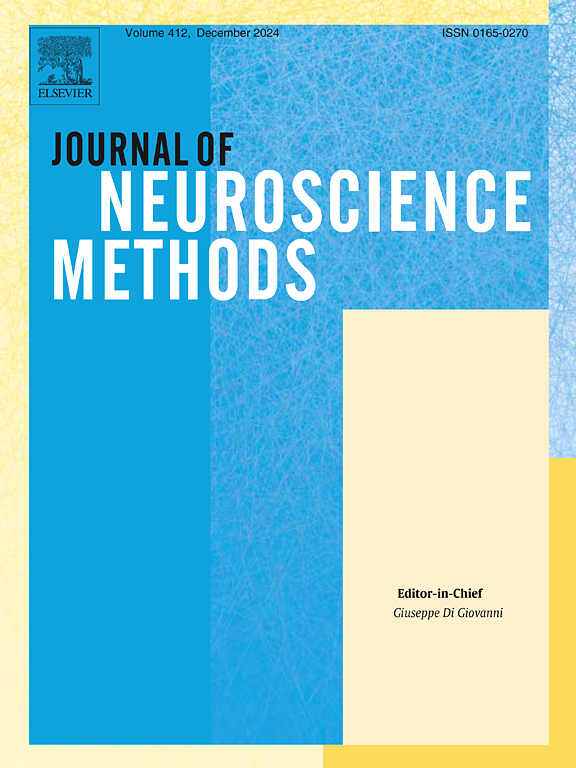Intra-rater reliability and validity of neuro-mobinavigation: A mobile app and laser-guided system of motor HotSpot localization
IF 2.3
4区 医学
Q2 BIOCHEMICAL RESEARCH METHODS
引用次数: 0
Abstract
Background
Optimal transcranial magnetic stimulation (TMS) efficacy depends on precise coil placement and orientation, as even minor deviations can significantly change the excitation evoked when stimulating the primary motor cortex (M1). To compare the intra-rater reliability of a novel method for consistent TMS coil orientation over a predetermined hotspot in M1, and to benchmark its accuracy against non-navigated method.
New method
A three-step method was employed. First, a laser-guided-system stabilized head position. Second, a mobile-app monitored coil tilt and orientation. Finally, coil position was marked on participant's head cap for visual reference for both methods. Twenty-nine healthy-participants underwent six TMS blocks of 20 pulses each. Six experimental blocks, alternating between non-navigated-TMS and Neuro-Mobinavigated-TMS, to investigate the parameters of motor evoked potential (MEP). The experimental blocks were quasi-randomized with a five-minute interval.
Results and comparison with existing method(s)
The novel method demonstrated excellent intra-rater reliability (ICC = 0.95, 95 % CI: 0.90–0.97) compared to moderate intra-rater reliability of the non-navigated TMS (ICC = 0.73, 95 % CI: 0.57–0.85) for MEP peak amplitude. Repeated measures ANOVA for novel-method showed consistent peak amplitude across three blocks (p = 0.078), non-navigated TMS exhibited significant variations (p < 0.0001). Wilcoxon signed rank test revealed significantly higher mean peak amplitudes for the novel method (1.02 ± 0.74) compared to non-navigated TMS (0.78 ± 0.61) (p < 0.001), small effect size (r = 0.35).
Conclusions
Neuro-Mobinavigation is superior to non-navigated method and provides a reliable and cost-effective alternative for MEP studies where gold standard neuronavigation is not available.
神经运动导航的内部信度和有效性:一种运动热点定位的移动应用和激光制导系统。
背景:经颅磁刺激(TMS)的最佳效果取决于精确的线圈位置和方向,因为即使很小的偏差也会显著改变刺激初级运动皮层(M1)时所引起的兴奋。比较在M1预定热点上一致TMS线圈方向的新方法的内部可靠性,并对其与非导航方法的精度进行基准测试。新方法:采用三步法。首先,激光制导系统稳定了头部位置。其次,一个移动应用程序监测线圈的倾斜和方向。最后,线圈的位置被标记在参与者的头帽上,作为两种方法的视觉参考。29名健康参与者接受了6次经颅磁刺激,每组20次脉冲。采用非导航-经颅磁刺激和神经运动导航-经颅磁刺激交替进行6个实验块,研究运动诱发电位(MEP)参数。实验块是准随机的,间隔5分钟。结果及与现有方法的比较:与非导航TMS (ICC = 0.73, 95% CI: 0.57-0.85)相比,新方法在MEP峰值幅值方面表现出优异的内部信度(ICC = 0.95, 95% CI: 0.90-0.97)。新方法的重复测量方差分析显示三个区块的峰值振幅一致(p = 0.078),非导航TMS表现出显著差异(p < 0.0001)。Wilcoxon符号秩检验显示,新方法的平均峰幅(1.02±0.74)显著高于非导航TMS(0.78±0.61)(p < 0.001),效应量小(r = 0.35)。结论:神经运动导航优于非导航方法,为没有金标准神经导航的MEP研究提供了可靠和经济的选择。
本文章由计算机程序翻译,如有差异,请以英文原文为准。
求助全文
约1分钟内获得全文
求助全文
来源期刊

Journal of Neuroscience Methods
医学-神经科学
CiteScore
7.10
自引率
3.30%
发文量
226
审稿时长
52 days
期刊介绍:
The Journal of Neuroscience Methods publishes papers that describe new methods that are specifically for neuroscience research conducted in invertebrates, vertebrates or in man. Major methodological improvements or important refinements of established neuroscience methods are also considered for publication. The Journal''s Scope includes all aspects of contemporary neuroscience research, including anatomical, behavioural, biochemical, cellular, computational, molecular, invasive and non-invasive imaging, optogenetic, and physiological research investigations.
 求助内容:
求助内容: 应助结果提醒方式:
应助结果提醒方式:


